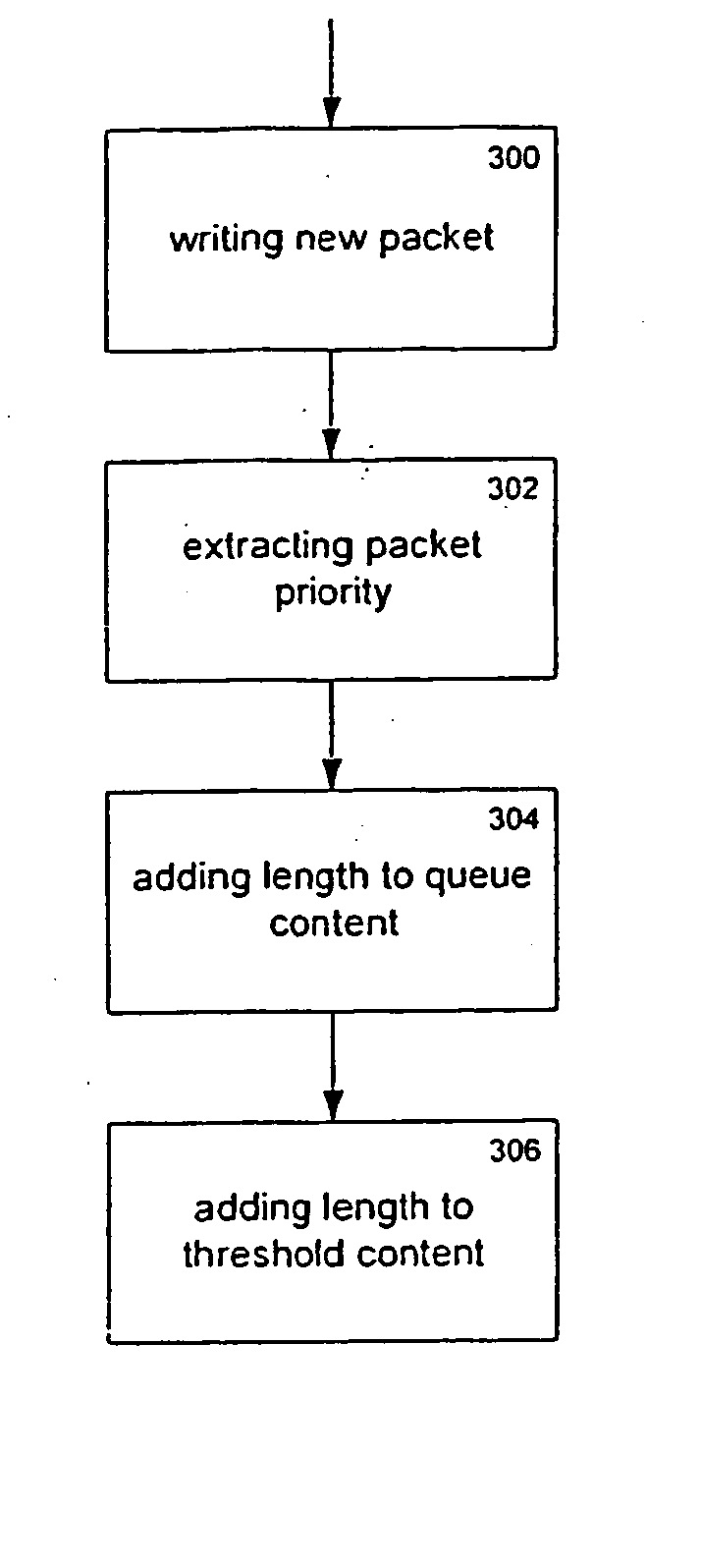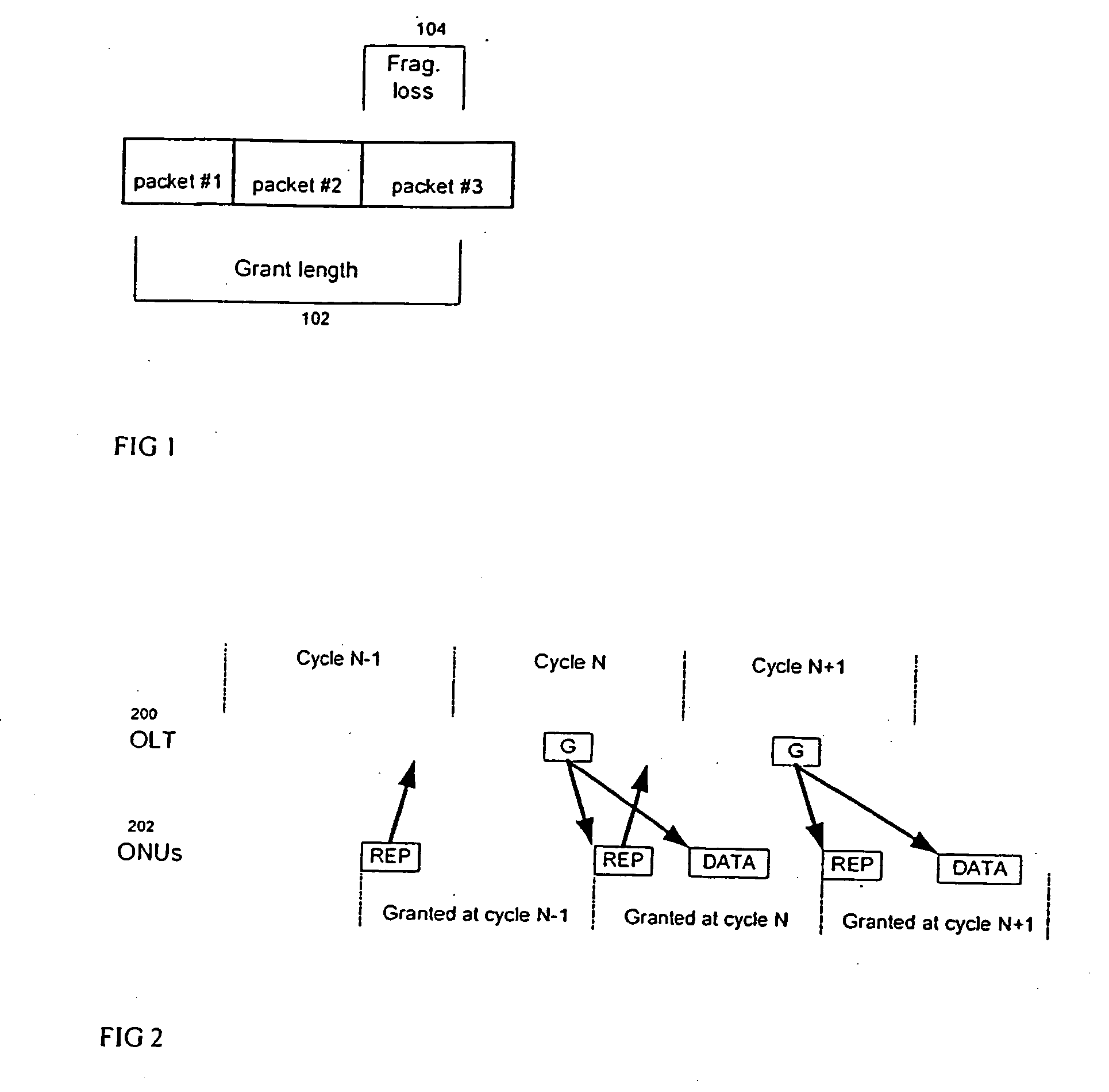Methods for dynamic bandwidth allocation and queue management in ethernet passive optical networks
- Summary
- Abstract
- Description
- Claims
- Application Information
AI Technical Summary
Benefits of technology
Problems solved by technology
Method used
Image
Examples
first embodiment
[0042] In a threshold setting method according to the present invention there is provided a mechanism that adjusts dynamically the thresholds, using an improvement on a prior art mechanism. This mechanism is called Weighted Fair Queuing (WFQ) and is adapted herein to a distributed switching architecture, as the ONU is remotely controlled by the OLT. The “adaptation” includes enhancing the WFQ algorithm by introducing a threshold concept inside it. The WFQ method and its derivatives are based on ordering the traffic in classes (“classification”). The classification process is well known in the art. Each class receives a constant share of the bandwidth. For example, class 1 has 40%, class 2 has 30%, class 3 has 10%, and class 4 has 20% of the bandwidth. This guarantees deterministic and fair bandwidth control. In order to support WFQ, an ONU must support classification. Flows based on packet parameters are directed to specific classes.
[0043]FIG. 8 shows an implementation of WFQ using ...
second embodiment
[0047] In a threshold setting method according to the present invention, there is provided a mechanism that adjusts dynamically the thresholds to predict the reported bytes below threshold. This mechanism is named Target Bandwidth Adaptation (TABA). The goal is to match a grant length as closely as possible to a desired length. The mechanism sets all threshold values of all sub-queues to be identical. That is, all priorities have the same threshold. The main concept is to increase the threshold values when the sum of reported bytes below threshold of all priorities is too low, and to decrease the threshold values when the sum of reported bytes below threshold of high priority queues is too high. The concept is illustrated in FIG. 9
[0048]FIG. 9 shows a flow chart of the steps of a threshold setting method using the TABA mechanism. The flow chart shows the handling of one ONU by an OLT related state machine. As with the WFQ embodiment of FIG. 8, for support of multiple ONUs, the OLT s...
third embodiment
[0051] In a threshold setting method according to the present invention there is provided yet another mechanism that adjusts dynamically the thresholds to predict as close as possible the traffic partition between priorities. This mechanism is named Priority Traffic Monitor (PTM). As opposed to the previous (TABA) method, each priority has in this case a unique threshold value, based on the amount of data arriving from the priority. The main concept is to set the sum of all thresholds to a fixed value, typically larger than the length of a desired grant. The threshold values are adjusted based on actual “bytes below threshold” reported per sub-queue associated with a priority.
[0052]FIG. 10 shows a flow chart of the steps of a threshold setting method using the PTM mechanism. The flow chart shows handling of one ONU by an OLT related state machine. As in the two previous (WFQ and TABA) methods, the PTM method may be used with a plurality of ONUs, by providing multiple instances of th...
PUM
 Login to View More
Login to View More Abstract
Description
Claims
Application Information
 Login to View More
Login to View More - R&D
- Intellectual Property
- Life Sciences
- Materials
- Tech Scout
- Unparalleled Data Quality
- Higher Quality Content
- 60% Fewer Hallucinations
Browse by: Latest US Patents, China's latest patents, Technical Efficacy Thesaurus, Application Domain, Technology Topic, Popular Technical Reports.
© 2025 PatSnap. All rights reserved.Legal|Privacy policy|Modern Slavery Act Transparency Statement|Sitemap|About US| Contact US: help@patsnap.com



